Dermatologic surgery abroad
Dermatologic Surgery is a component of plastic and reconstructive surgery. It aims to treat skin tumors, whether benign or malignant.
Skin tumors are lesions of the skin. They can be in the form of spots or skin growths. They may differ in shape, size and color depending on their nature and duration of disease.
There is a wide variety of tumor types ranging from banal nevus (mole) to the rare tumor hardly diagnosable. These tumors can exist from birth (congenital tumors) or appear later.
These skin tumors are often found incidentally or can be diagnosed by your doctor or dermatologist, who then directs you to a plastic surgeon for their surgical removal.
Visually, it is not always possible to differentiate a benign tumor malignancy. It is necessary in this case a biopsy with histological examination to confirm the nature of the injury.
We can differentiate two types of skin tumors:
1. Benign tumors:Benign tumors can be removed surgically in these following cases:
- They may evolve to malignancy (resection is then performed as a preventive).
- They are annoying (causing friction and irritation due to their location) or are unattractive.
There are several different forms of benign tumors that are common, we can mention especially:
Nevi (or moles):The nevi are benign tumors. Of melanocytic origin, they are generally pigmented. Several factors may be the reason behind the weakening of nevi making it more likely to be cancerous, as melanoma such as: repeated sun exposure, genetic factors, mechanical irritation, etc.
Lipomas:Lipomas are benign fat tumors, that are very common and insensitive. However, such tumors are sometimes perceived as being generally very troublesome because of their state or volume.
Cysts :Cysts are glandular skin tumors quite mild and very frequent whose secretions (sebum and keratin) collects in a pocket...
2. Malignant tumors:These tumors are similar to skin cancer. They must be removed surgically by amputation in most cases.
To minimize the risk of recurrence, surgical excision must meet a “margin of safety” around the tumor. These tumors are sarcomas, carcinomas or melanomas.
Basal carcinoma cell, squamous cell carcinoma and melanoma are the most common skin cancers.
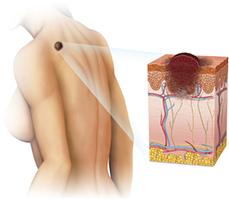
Basal cell carcinomas account for about 60 % of skin cancers and therefore are common injuries. It is important to hinder the development of this lesion to avoid ulceration, even if these carcinomas never give rise to metastases.
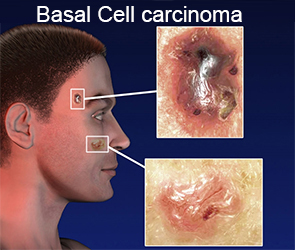
Plastic surgery of skin tumors in Tunisia involves removal of part more or less extent (width or depth) of the skin so that the removal of the skin tumor is complete. Dr. Chiraz Bouzguenda determines the best technique to use, to get the best result possible.
Several reasons justifying Dermatologic Surgery:
- It is a cancer, tumor or a susceptible to become one
- This is a benign tumor but is inconvenient or unattractive.
Dermatologic Surgery requires specific techniques and must meet well-defined standards. Indeed, discarding the case of melanoma is a serious disease; most skin lesions are curable permanently. It is therefore required to take every precaution, respecting the necessary safety margins (variable depending on the type of injury) to remove the definitively the lesion.
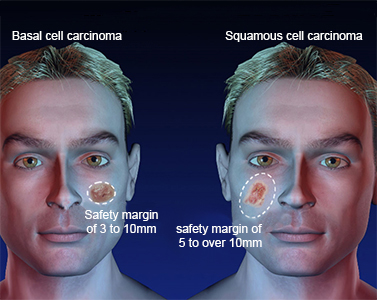
So that the scar is as discreet and the most aesthetic, it is essential to choose the orientation of the spindle excision of skin tumors respecting the natural tension lines of the skin, so that scar removal surgery can be avoided later.
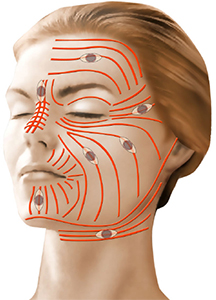
Some cases can be very simple requiring only excision full thickness of the skin with suture edge to edge. This procedure is fast and efficient: No preparation or prior technical considerations.
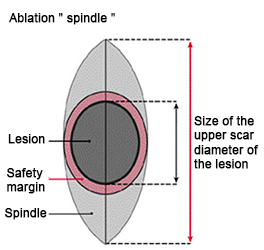
Other cases require sophisticated techniques of plastic surgery: surgery of local or remote, tattered, skin graft ... These require a good strategy from the plastic surgeon. The goal is to achieve optimum results both in oncological and aesthetically.
In all cases, it is essential to conduct a systematic histological analysis of all skin lesions.
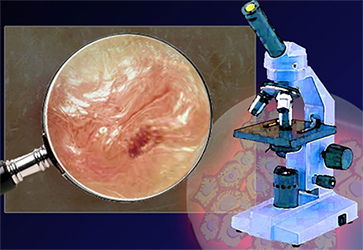
Generally, the supported patient has already had an initial consultation with a dermatologist. So at this stage has an established diagnosis of the skin abnormality requiring the intervention of a plastic surgeon who will advise him the steps for its dermatological surgery.
It is therefore unnecessary for the surgeon to spend time reconfirming an already established diagnosis. His role will be rather, considering an intervention in the best conditions.
This consultation with Dr. Shiraz Bouzguenda allow it to define the area to be treated and techniques to follow to achieve the removal of the skin tumor .
In most cases, of course, subject to age, physical condition and treatment received by the patient, these operations can be performed as an outpatient. Local anesthesia is in most cases sufficient.
the sequels of dermatologic surgery are fortunately not painful. Immediately after the intervention, apply a bandage over the wound. This must be changed regularly during the first few days after the intervention of Dermatologic Surgery.
Basal cell carcinomas are among the malignant tumors of the skin, but have only local malignancy. Indeed, they do not generate metastases or ganglia. It is crucial to their removal from their discovery as they may increase in size and be intrusive to the surrounding tissues (skin, muscle, bone ...) and thus complicate their surgical excision. Squamous cell carcinomas against generate by distant metastases (especially in the lungs).
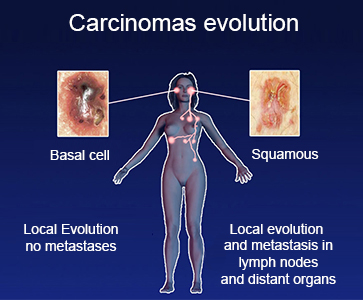
Malignant melanomas, known to be the mole cancer have a generally severe evolution, invading surrounding tissues and giving distant metastases and lymphadenopathy .
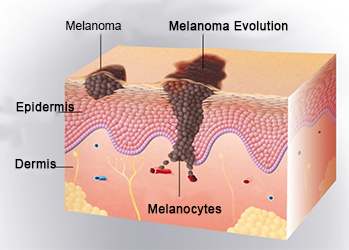
Dermatologic surgery Tunisia
- Procedure: Excision of benign and malignant skin tumors followed by tissue reconstruction.
- Anesthesia:Local or local potentiated.
- Operating time: 1 hour.
- Duration of hospital stay: 1 day
- Recovery: 7 days.
